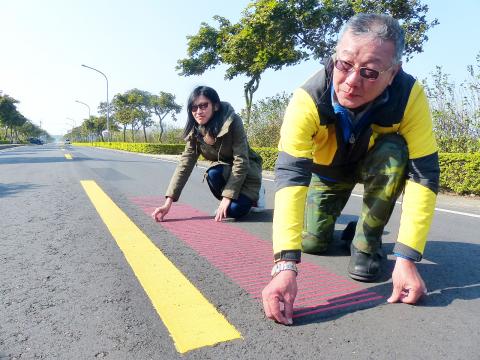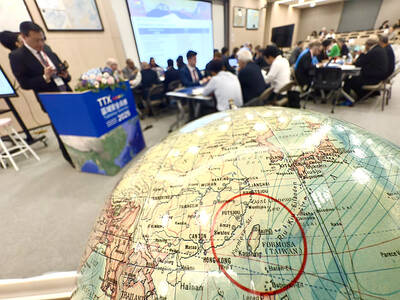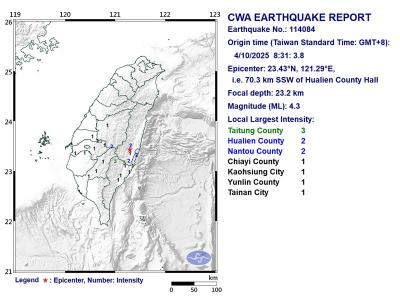The nation’s first “musical road” was unveiled in Kinmen’s Dinglin Road (頂林路), where cars driving at 50kph play a tune generated by the vibrations between their wheels and the notches placed on the road, a team of researchers from National Quemoy University said.
First conceived in Denmark, musical roads aim to keep drivers awake and encourage them to drive under the speed limit, said Liao Yi-chun (廖翊君), a civil engineering student at the university.
The 85-meter-long section of road in Kinmen is an improved version of an experimental project by the university, researchers said, adding that the new section was paved on the same stretch of Dinglin Road to replace the original patch paved two months ago, which was eroded by rain.

Photo: Wu Cheng-ting, Taipei Times
The project was funded by the Ministry of Science and Technology, the researchers said.
The previous version of the road played a section from Beethoven’s ninth Symphony, while the new one plays a section from The Olive Tree, a Taiwanese song by Chyi Yu (齊豫), they said.
Some drivers were cited by the researchers as joking that they wonder whether drivers who are unaware of the design would be scared or delighted when driving over the road and hearing a song.
Conventional musical roads use grooves cut into the road surface to generate the desired tune, but the team in Kimen used household anti-slip strips to the same effect, without the need to permanently alter the existing road, said Shui Li-fu (水利夫), research team member and a civil engineering student at the university.
“The road in Kinmen is designed to keep drivers awake with music while giving an audible warning to drivers who exceeded the speed limit by making discordant and high-pitched sounds,” Shui said.
While the Ministry of Science and Technology’s funding only covered the cost of building a short stretch of road that plays eight notes, the team hopes that the Kinmen County Government would allocate a budget for a full installation, the researchers said, adding that they might change the tune to the Republic of China anthem if they receive funding.

DEFENSE: The National Security Bureau promised to expand communication and intelligence cooperation with global partners and enhance its strategic analytical skills China has not only increased military exercises and “gray zone” tactics against Taiwan this year, but also continues to recruit military personnel for espionage, the National Security Bureau (NSB) said yesterday in a report to the Legislative Yuan. The bureau submitted the report ahead of NSB Director-General Tsai Ming-yen’s (蔡明彥) appearance before the Foreign and National Defense Committee today. Last year, the Chinese People’s Liberation Army (PLA) conducted “Joint Sword-2024A and B” military exercises targeting Taiwan and carried out 40 combat readiness patrols, the bureau said. In addition, Chinese military aircraft entered Taiwan’s airspace 3,070 times last year, up about

Taiwan is stepping up plans to create self-sufficient supply chains for combat drones and increase foreign orders from the US to counter China’s numerical superiority, a defense official said on Saturday. Commenting on condition of anonymity, the official said the nation’s armed forces are in agreement with US Admiral Samuel Paparo’s assessment that Taiwan’s military must be prepared to turn the nation’s waters into a “hellscape” for the Chinese People’s Liberation Army (PLA). Paparo, the commander of the US Indo-Pacific Command, reiterated the concept during a Congressional hearing in Washington on Wednesday. He first coined the term in a security conference last

A magnitude 4.3 earthquake struck eastern Taiwan's Hualien County at 8:31am today, according to the Central Weather Administration (CWA). The epicenter of the temblor was located in Hualien County, about 70.3 kilometers south southwest of Hualien County Hall, at a depth of 23.2km, according to the administration. There were no immediate reports of damage resulting from the quake. The earthquake's intensity, which gauges the actual effect of a temblor, was highest in Taitung County, where it measured 3 on Taiwan's 7-tier intensity scale. The quake also measured an intensity of 2 in Hualien and Nantou counties, the CWA said.

The Overseas Community Affairs Council (OCAC) yesterday announced a fundraising campaign to support survivors of the magnitude 7.7 earthquake that struck Myanmar on March 28, with two prayer events scheduled in Taipei and Taichung later this week. “While initial rescue operations have concluded [in Myanmar], many survivors are now facing increasingly difficult living conditions,” OCAC Minister Hsu Chia-ching (徐佳青) told a news conference in Taipei. The fundraising campaign, which runs through May 31, is focused on supporting the reconstruction of damaged overseas compatriot schools, assisting students from Myanmar in Taiwan, and providing essential items, such as drinking water, food and medical supplies,